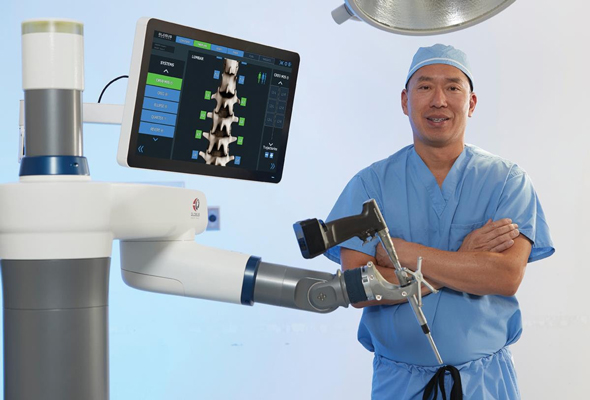
The Spine Center at MemorialCare Long Beach Medical Center is the only hospital in Los Angeles County offering ExcelsiusGPS® for spine surgery. Spine surgeons trained in ExcelsiusGPS at Long Beach Medical Center can perform spine procedures that can result in shorter hospital stays, less tissue damage and smaller incisions, which may lead to smaller scars.
When performing spine surgery — particularly with spinal screw and rod placement — precision is key. Screws and rods are used in spinal fusion surgery to add support and strength. Screws are placed into two vertebrae at the level to be fused. A rod is used to connect the screws which prevents movement and allows the bone graft to heal.
ExcelsiusGPS is designed to improve accuracy and optimize patient care by using robotic navigation, much like a GPS in your car. Preoperatively, a CT scan is taken and imported into ExcelsiusGPS. The surgeon uses these images to determine the pre-operative plan for the procedure to include size and placement of screws and rods based on the individual’s anatomy precisely tailoring the surgery to each patient.
ExcelsiusGPS is used to treat a wide variety of disorders that require surgical procedures to either stop motion or correct malalignment of the vertebrae of the spine. Some of the more common surgical spine procedures that can be performed with ExcelsiusGPS include:
- Fracture repair: Fractured bones are repaired through surgery using metal screws, plates, or other implants to secure the fracture while it heals. Surgery may involve fixation of the fracture with plates, screws, nails or external fixation.
- Posterior cervical decompression and fusion: Relieves pressure on the nerve roots or spinal cord in the cervical spine. Screws and rods hold the spinal column in place while fusion occurs to provide stability. Overtime, the vertebrae can grow together through fusion.
- Lateral lumbar interbody fusion: With a lateral lumbar interbody fusion, minimally invasive surgery is used to treat disc problems in the low back. In spinal fusion, two or more bones of the spine are joined to stop painful motion, decompress pinched nerves, and correct scoliosis. In some cases, the graft is strengthened with a plate and screws on the side or with pedicle screws from the back.
- Sacroiliac joint fusion: The sacroiliac joints connect the base of the spine (sacrum) to the hip bones (ilium). In a sacroiliac joint fusion, rod and/or screw devices are placed across the joint to stop painful motion.
- Scoliosis correction: Scoliosis is an abnormal curvature of the spine that may be treated with observation, bracing or surgery. Screws and rods are placed on each side of the vertebrae to match the desired corrected curvature of the spine and add stability.
Don’t delay care for chronic back pain any longer. To learn more about ExcelsiusGPS at Long Beach Medical Center, visit memorialcare.org/SpineSurgery.
